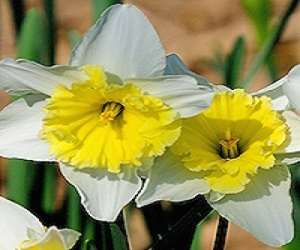By Norman Winter
The first hint of spring is trumpeting, so to speak, in the South with the arrival of the narcissus, or daffodil. I hate writing about flowers that are opposite their planting season, but on the other hand, there are certainly some lessons to be learned. The biggest lesson is learning which of these flowers will naturalize in your area. You have to admit that looking at a catalog of daffodil blooms will make you want each and every one.

Over the years, I have been blessed to go to farms in Louisiana with Bill Welch of Texas A&M University while he was researching his book, “The Southern Heirloom Garden.” Seeing acres of naturalized ‘Campernelli’ daffodils will be an everlasting memory. While most of us don’t have acres of land to cultivate, we would like to see our daffodils become happy and naturalize.
In the hot and humid conditions of Georgia, many of those famous, large selections may look great the first year, but offer few, if any, blooms the second year. In no way am I disparaging these varieties. On the other hand, I was recently assisting a commercial horticulturist with a large project in which 20,000 bulbs had to be planted in a high-profile location. We needed the bulbs to look good the first year and in subsequent years, too. I knew what I was taught at Texas A&M University, but I needed a little reaffirmation.
I turned to the book, “Daffodils in Florida,” by Linda M. and Sara L. Van Beck. To me this is the definitive guide to enabling our region of the country to not only create daffodil heaven, but reside in it. We decided to go with the ‘Carlton’ daffodil for the large, 20,000-daffodil display. This 1927 selection was one of the varieties that was ingrained in my memory as being superior. The book says this flower should be the backbone of any daffodil bed. True enough, it has been a remarkable selection.
Perhaps in your specific area, ‘Carlton’ won’t be a stalwart performer, but I assure you that there is a narcissus that will bring cheer to your landscape. Speaking of cheer, here at the Coastal Georgia Botanical Gardens at the Historic Bamboo Farm, ‘Ice Follies’ has proven to be a winner, as has a small, 1934 double tazetta daffodil by the name of ‘Erlicheer.’ It brings out the cameras just as quickly as a large trumpet. The ‘Grand Soleil d’Or’ is another tazetta; dating back to 1770, it is showing now in our Mediterranean Garden.
Daffodils prefer sunny locations, although open shade will not prove to be a big detriment. For best naturalization, plant your bulbs in a well-drained area. Raised beds rich in organic matter are perfect for combining pansies and daffodils. Plant the bulbs about twice as deep as they are tall, 5 to 6 inches for large bulbs and 3 to 5 inches deep for smaller ones. Spacing 6 to 8 inches apart will allow for an increase in size before crowding.
One of the biggest mistakes gardeners make in growing daffodils is cutting the foliage after the flowers have diminished. The leaves are vital to next year’s bloom. Leave them growing as long as possible or for at least eight weeks. I’m proud to say our high-visibility location lets the daffodils grow until the foliage disappears on its own. The result has been an amazing stand that’s not only getting naturalized, but is increasing in size.
I would be remiss if I didn’t urge you to grow the daffodil in mixed containers as well. Containers with pansies, violas and dianthus will become like a spring crescendo of floral beauty. Visit a public garden like the University of Georgia Coastal Georgia Botanical Gardens in Savannah, Georgia, this spring and seek out the best narcissus for your area. You’ll enjoy the beauty for years to come.
Source: uga.edu